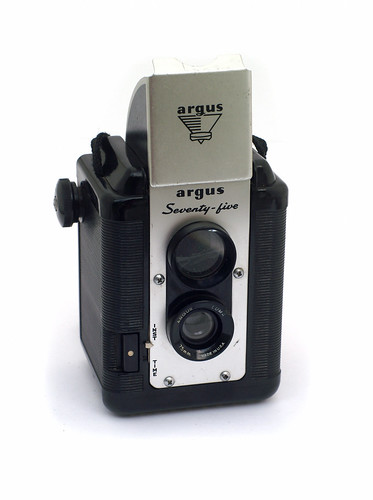Difference between revisions of "Argus Argoflex Seventy-Five"
(image link) |
(expanded to full coverage) |
||
| Line 6: | Line 6: | ||
}} | }} | ||
| − | + | ||
| − | The '''Argoflex Seventy-Five''' and '''Argus Seventy-Five''' were | + | The '''Argoflex Seventy-Five''' and '''Argus Seventy-Five''' were two name variants of the same model of [[pseudo TLR]], produced by [[Argus]] in the USA, beginning in 1949. |
| + | |||
| + | The main body was molded from plastic (perhaps [[bakelite]]), while the film door is a painted metal casting. The front panel and viewfinder hood are in a contrasting satin-finish metal. A cloth neckstrap is permanently attached to the top of the body. | ||
| + | |||
| + | Images were 6x6cm on [[620 film]]. While essentially a simple camera, it did feature double-exposure prevention, as well as a clever red-painted shutter blade visible through the taking lens only after the shutter is cocked. Frame spacing relied on a simple [[red window]], however. | ||
| + | |||
| + | The lens was branded as a 75mm Lumar, and was a single meniscus element in front of a fixed aperture of approximately f/11. Next to the shutter release, a small slider selected between "Inst" (instant) and "Time" (actually bulb). | ||
| + | |||
| + | A standard Argus Seventy-Five kit would typically have included a leather protective case, flashbulb holder (mounted with two pins 1-3/16" apart), and a slip-on accessory "portrait" lens to focus in the 3 to 4 foot range. | ||
| + | |||
| + | The final version of the Seventy-Five in production until 1964 received a modest redesign of its graphics, becoming the [[Argus 75]]. | ||
| + | |||
| + | Owners hoping photograph with a Seventy-Five using currently-available [[120 film]] will find that a 620 take-up spool is required. It is impossible to fit a 120 spool into the take-up compartment, as its dimensions are too small in all directions. However, a fresh roll of 120 can just barely be squeezed into the supply compartment, perhaps with some trimming down of the spool flanges. | ||
| + | |||
| + | ==Bibliography== | ||
| + | {{Argomania}} | ||
| + | |||
==Links== | ==Links== | ||
Revision as of 06:05, 27 February 2011

|
| by Capt Kodak (Image rights) |
The Argoflex Seventy-Five and Argus Seventy-Five were two name variants of the same model of pseudo TLR, produced by Argus in the USA, beginning in 1949.
The main body was molded from plastic (perhaps bakelite), while the film door is a painted metal casting. The front panel and viewfinder hood are in a contrasting satin-finish metal. A cloth neckstrap is permanently attached to the top of the body.
Images were 6x6cm on 620 film. While essentially a simple camera, it did feature double-exposure prevention, as well as a clever red-painted shutter blade visible through the taking lens only after the shutter is cocked. Frame spacing relied on a simple red window, however.
The lens was branded as a 75mm Lumar, and was a single meniscus element in front of a fixed aperture of approximately f/11. Next to the shutter release, a small slider selected between "Inst" (instant) and "Time" (actually bulb).
A standard Argus Seventy-Five kit would typically have included a leather protective case, flashbulb holder (mounted with two pins 1-3/16" apart), and a slip-on accessory "portrait" lens to focus in the 3 to 4 foot range.
The final version of the Seventy-Five in production until 1964 received a modest redesign of its graphics, becoming the Argus 75.
Owners hoping photograph with a Seventy-Five using currently-available 120 film will find that a 620 take-up spool is required. It is impossible to fit a 120 spool into the take-up compartment, as its dimensions are too small in all directions. However, a fresh roll of 120 can just barely be squeezed into the supply compartment, perhaps with some trimming down of the spool flanges.
Bibliography
Gambino, Henry J. Argomania: A Look At Argus Cameras and the Company That Made Them. Doylestown, PA: Aeone Communications 2005. ISBN 0-9770507-0-X